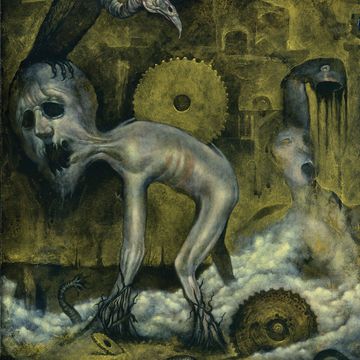In 1987, my mother bought an IBM personal computer and installed it in our home. It was an expense for her mail-order business, Rainbow Designs, which sold patterns for plushie toys she created. Richard, the man who set up the machine, also included a generous number of games for us. The day he came, they called me, then eight years old, into the office to try out Police Quest, by Sierra On-Line, a software company cofounded by Roberta Williams, one of the most successful game designers of the era.
In Police Quest, you’re Sonny Bonds, a cop attempting to bust a drug ring in the fictional city of Lytton, California. Today, Sierra games look primitive, with their pixelated images and garish backgrounds, but at the time, Police Quest was cutting-edge. The adults seemed baffled by the new technology, but I immediately understood what it was. As soon as I made Sonny pull over a female driver and kiss her on the lips instead of giving her a speeding ticket—a scenario I found hilarious—I knew I was dealing with an interactive story. Or, as I thought of it, a cartoon I could control. As a child who loved storytelling, I was hooked.
Piracy was a nonexistent concept at the time, at least to us, so we had no qualms about accepting more free games from Richard. There was Space Quest, a cross between Star Wars and Star Trek, and the raunchier Leisure Suit Larry, which had an adults-only trivia quiz at the front that was laughably easy to pass. And there was my favorite, King’s Quest, a fantasy series in which a king wanders around a fairy-tale land encountering characters like Little Red Riding Hood, Neptune, and Count Dracula. For hours, I moved the man with cursor keys while frantically typing in commands like “give Neptune trident” or “open coffin.” Today, I attribute my speedy typing skills to playing these games.
This article appears in Issue 27 of Alta Journal.
SUBSCRIBE
In my school in Arcata, where I grew up, I was the only kid who owned a computer. Other children had Nintendo, and I enjoyed playing Super Mario Bros. and Donkey Kong at their homes. Privately, however, I considered adventure games like King’s Quest superior. In fact, except for reading books or making up my own stories, I can’t think of anything that possessed me with such passion as Sierra games. Just as I wanted to stay up all night finishing an exciting novel, I wanted to stay up playing the latest quest. The psychological term for this is cathexis, the “investment of mental or emotional energy in a person, object, or idea,” according to Merriam-Webster. It has the excitement of a crush without the sexual overtones. Or maybe it’s akin to creative inspiration, when you fall in love with an idea and can think of nothing else. To be so engaged is a pleasurable state of mind.
King’s Quest and its seven sequels were designed by Williams. Along with her husband, Ken, she built Sierra into one of the earliest and biggest gaming companies, with $158 million in revenue and almost a thousand employees at its peak. Williams held a rarefied position as a company head who was also a female. Even today, women make up only 24 percent of game developers, despite being almost half of players.
I didn’t know this when I was a child, of course. From my perspective, my favorite games were made by a company owned by a woman, so it appeared to be a field where I was welcome. It wasn’t long before I added “making games” to the list of things I wanted to do when I grew up. From ages 8 to 12, I considered it seriously along with fashion designer, actor, private detective, and novelist. I even mapped out my own story, drawing the world and thinking through plot, though I had no idea how to get it onto a computer.
When I mentioned to adults that I might want to design games for a living, I encountered a common scenario for girls interested in STEM careers. Relatives told me I’d hate game design. For one thing, programming required a lot of math. Did I want to do math when I grew up? they asked. No, I did not! I replied. I hated math class so much. After just a few conversations, gaming changed from building imaginative worlds to doing homework.
To this day, I remember the disappointment I felt. It wasn’t just that I believed the adults; their assessment also sucked the creativity out of gaming for me. The stories I liked now appeared to be a facade for numbers trailing down a screen. In this, I believed several lies, including that programming isn’t creative, when of course it is, and that I would hate the math involved because (it was implied) I would be “bad” at it. And this assumption was tied, obscurely but definitely, to my gender.
Besides, my first instincts were right. Williams was helping pioneer a new form of storytelling, and for her, at least, math had little to do with it.
HOUSE OF GAMES
In 1979, the story goes, Ken Williams bought an Apple II computer and set it up on his kitchen table. Roberta was a homemaker with two small children, and he was a programmer and salesperson. According to Ken’s self-published autobiography, Not All Fairy Tales Have Happy Endings, he logged in to a Massachusetts Institute of Technology network and discovered a game called Colossal Cave Adventure (or ADVENT). It was text-based, and players typed commands to navigate a cave filled with treasure.
When Roberta saw the game, she pushed her husband aside and wouldn’t get up from the computer again for hours. “I just couldn’t stop,” she later said in an interview. “It was compulsive. I started playing it and kept playing. I had a baby at the time, [who] was eight months old; I totally ignored him. I didn’t want to be bothered. I didn’t want to stop and make dinner.”
In his book, Ken comes off as a money-hungry businessman whose goal in life is to be wealthy: “Note that I said ‘rich’ not ‘employed’ or ‘successful.’ ” He and Roberta met in 1971 as teenagers living near Los Angeles, Claremont for her and Pomona for him. After a short period, Ken “informed” Roberta that they were getting married. He teamed up with her dad, and the two men blocked other romantic interests and pushed her into accepting the proposal. “It took a few dates to sell Roberta on the idea of marriage but closing a sale is what I do best,” he writes.
There’s something of the elephant and the dove about the Williamses. Roberta is petite, with dark blond hair, a broad nose, and a timid demeanor that reminds me of an elf. Ken, tall and unkempt, with a Dr. Phil mustache, towers over her. By the time they discovered Colossal Cave Adventure, he’d worked several programming jobs that he’d lied his way into. “If there was a particular skill set I wanted to learn…I would claim to be an expert, and if given an interview I would binge study all night…then charm my way into the job,” he writes.
After Roberta finished Colossal Cave Adventure, she looked for something else to play. When she ran out of options, she resolved to create her own game. It would be a mystery, a cross between Clue and the Agatha Christie novel And Then There Were None. To make it, she first wrote the story, then mapped it out, drawing each screen and deciding what would happen as a kind of storyboarding.
Ken was too busy to pay attention to his wife’s idea, despite her repeated attempts to tell him about it. Finally, she lured him out to dinner at a steakhouse with the promise of a surprise. Once there, she told him about the game she wanted him to code. But, she added, the project wasn’t just for fun. Roberta was proposing a product to sell so they could earn a down payment on a new house.
“As Roberta was talking, I was listening closely,” Ken writes. “She had finally captured my interest!”
They understood the consumer-technology market well. Not only had Roberta played most games, but Ken was a software distributor, selling to computer stores up and down the West Coast out of the trunk of his car. At dinner, they hit upon a way to give their game a competitive edge: it would have graphics.
This posed a challenge, as images were data heavy, requiring many disks. Finally, they settled on VersaWriter, a device that allowed Roberta to digitize her sketches of stick figures in a blocky house. The images took up small amounts of data, making graphics a viable option. The result, Mystery House, was the first visual game. It was a huge hit.
Like my mom’s mail-order business, Sierra started at home. Ken continued to go to work, while Roberta stuffed disks into ziplock bags along with an instruction sheet run off at a copy shop. Soon, the phone was ringing off the wall with orders. In the first month, they made $8,000; the next, $20,000; “and it went up from there,” Roberta told a reporter.
On the Mystery House profits, they bought a home in Oakhurst, outside Yosemite National Park—thus the name Sierra On-Line.
GENDERED EXPECTATIONS
From 1979 to 1996, Sierra was a leading computer-game company, boasting many firsts in the field. Roberta’s ideas pushed the engineers to achieve what they initially deemed impossible, leading to a long list of innovations. After graphics, Sierra moved on to color images in Wizard and the Princess. The company was the first to incorporate licensed characters, use CD-ROMs and sound cards, hire professional musicians for scores, and film actors on a movie set.
Sierra was an example of what it looks like when a woman has a say at a large corporation. For one thing, the company was more open in its hiring practices. Unlike the competitors, which mostly employed college-educated white men, Sierra hired novice engineers and Oakhurst locals and “actively invited female designers,” according to digital culture magazine Mic. Female developers there included Jane Jensen, of the Gabriel Knight series; Lori Ann Cole, who cocreated Quest for Glory; and Lorelei Shannon and Christy Marx, who worked on multiple titles.
Crucially for me, Sierra produced one of the first major computer games with a female main character, King’s Quest IV: The Perils of Rosella. It was my favorite, no doubt because it starred a blond girl (like me) on an adventure in a magical world. Featuring a female protagonist was unusual. “I wondered if it was going to be accepted,” Roberta said in an interview. “I thought there would be some controversy, that maybe guys would write in and say, ‘I don’t want to be a girl’…but it hasn’t really been an issue.”
Meanwhile, no one questioned how girls felt playing a boy. Already, computer games were instilled with the cultural assumptions that stories about males are universal and that boys are more inclined to interact with technology and play games. It didn’t have to be that way, as the popularity of Sierra demonstrated. A 2015 Time survey of 1,400 middle and high school students found that 78 percent of boys and 70 percent of girls didn’t choose games based on the main character’s gender. This makes sense to me. While identification is important, as I learned with Rosella, there’s nothing inherently gendered about any type of game. Plenty of women like first-person shooters, and men enjoy life simulations such as The Sims, which is basically arranging dolls in a virtual dollhouse. Gendered expectations were put onto games by the people making them, which in turn shaped the industry into something increasingly seen as male-oriented.
In the 1990s, this took an even more unfortunate turn. The industry began promoting a new, toxic masculine culture surrounding the popularity of shooters like Resident Evil, Doom, and Quake. Sales of these games exploded, and companies scrambled to capture the growing audience. Soon, each gaming system was trying to outdo the last with an edgier “extreme” attitude. At the same time, there was an exodus of female designers from the field, according to Cole, who worked at Sierra. “Women who worked on those games found other jobs,” she told Mic. “Women who played adventure games…had nothing to play.”
In this new atmosphere, there was dismissiveness of anything deemed feminine. In 1998, the magazine PC Accelerator explained in “25 Greatest Guy Games” that “it takes a special game to classify as a real ‘guy’ game.… Extreme violence, gratuitous sex, beer, or sports are critical.” The article included a sidebar, titled “Games for Girly Men,” that disparaged adventure and role-playing titles, as well as Scrabble (“Wee dont nead not stinckin speling!”). This macho posturing was so prevalent that it paved the way, decades later, for Gamergate, a misogynistic harassment campaign against female players that was a bizarre attempt to “protect” gamer identities from corrupting forces—like feminism.
WOMEN IN TECH
In 1996, as these changes were emerging, Sierra was acquired by electronic-shopping company Comp-U-Card (CUC) for $1.06 billion. Roberta was against the deal, as she had “the world’s greatest job,” writes Ken. But by then, Sierra was a public entity, and shareholders could sue if the couple blocked a billion-dollar offer. Besides, Ken was tired and wanted a change. Once the sale went through, he resigned from Sierra, but Roberta stayed on to build King’s Quest VIII: Mask of Eternity.
Without ownership in the company or her husband by her side, Roberta experienced a situation common for women in tech: she struggled to be respected by an all-male team of engineers. They dismissed her ideas and cut her out of the decision-making. “Things started sneaking into the game that she didn’t put there,” writes Ken. “She would turn in thick stacks of change requests, only to have most of them ignored.” Some evenings, she came home crying.
As a result, King’s Quest VIII is widely considered the worst of the series. Gone were the magic, storytelling, and familiar characters. The new release was a murky role-playing game full of combat scenarios. Fans felt betrayed. “When is a King’s Quest not a King’s Quest?” wrote a player at the time. “When it’s King’s Quest: Mask of Eternity! Oh how I would have liked to have started this review in any other way.”
By then, Sierra was in trouble. In 1997, the Securities and Exchange Commission investigated CUC for accounting fraud, finding that it had severely inflated its numbers. The software division was sold off, and Sierra changed hands several times, dying a slow death. It was shuttered in 2004.
Luckily, the Williamses had cashed out before the company’s demise. Still, Roberta admitted to Vice, the change was devastating. “I don’t want to say ‘depression,’ I’m not a person that does that,” she said. “But I would say, I went through a period of, ‘What am I going to do now?’ And sadness. I still feel sad.… For twenty years I had been a computer game designer, and I was no longer that. It was like, ‘Well, now what am I?’ I was only about 42 years old. A little young yet to not have anything to do. What do I do?”
PASSED OVER
The Williamses spent two decades circumnavigating the globe in a boat, seeming to leave software behind for good. But during the COVID-19 pandemic, they turned their attention to the game that started it all, Colossal Cave Adventure. Last year, they released a reimagined, graphical version of the text-based original. Recently, I tried the game out. I was nonplussed by the dark graphics, which didn’t compare to the images my mind created when I played the text version. It was a little like watching a mediocre movie adaptation of a beloved book, and I found myself getting bored.
To be fair, this is usually the case when I play video games these days. While I can still be swept up by a book or TV show, I seem to have lost my love of gaming. The last title that excited me was 2001’s Black & White, in which you play a god worshipped by villagers. Even then, my passion was waning. I only made it through the second level.
Still, I miss being immersed in a virtual world. I’ve tried to get that feeling back by exploring different titles over the years. At one point, I even dragged out my old Windows machine to try Black & White again. No matter how sleek or groundbreaking the game, I couldn’t get back to that feeling of cathexis I experienced as a child. I’d simply forget to play or become listless, lacking the curiosity to get to the end. It took too much commitment. Playing wasn’t the same anymore. I wanted space. It’s not you, I told the games. It’s me.
Lately, I’ve been asking myself why I stopped enjoying gaming. Some of it was growing up and becoming more judicious with my time, but my lagging interest also coincided with the hypermasculine shift in the industry. While I liked games from that period, especially Doom, I was no longer captivated by new titles in computer stores. I must have realized on some level that games weren’t being made as often for a player like me.
Or maybe the change started earlier, back when my relatives discouraged me from being a game designer. Before that, I liked everything my mom’s PC offered—shooting space aliens, solving mysteries, playing computer chess games, answering trivia on virtual Jeopardy, “drawing” posters in MS Paint and printing them on our dot matrix printer. If someone had taught me a programming language, I’m sure I would have liked that, too. Maybe I would have made my own game. Who knows?
After the math incident, computer games changed for me. I still enjoyed them, but I became pickier and didn’t always play them to the end. As I aged, and as the industry changed around me, I turned from my old pastime so gradually that I became aware of it only when I realized I’d lost a source of joy that I missed. But it was too late, I found. At some point, the love of gaming shut down in me. And once that happened, I was unable to start it up again, no matter what commands I tried.•
Joy Lanzendorfer’s first novel, Right Back Where We Started From, was published in 2021. Her work has appeared in the New York Times, Washington Post, Raritan, the Atlantic, and Ploughshares as well as on NPR and for the Poetry Foundation, among others.


















